|
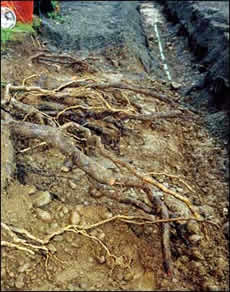 1. Trenching in the critical root zone can cut anchoring roots and increase blow down risk
1. Trenching in the critical root zone can cut anchoring roots and increase blow down risk
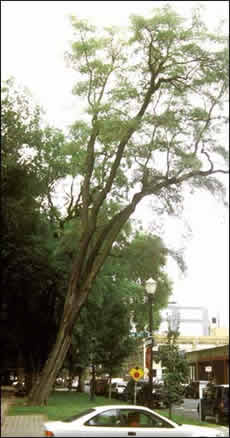 2. One of the eight warning signs of a hazard tree is a tree that has begun to lean. Pay close attention to trees that have recently moved from a vertical position.
2. One of the eight warning signs of a hazard tree is a tree that has begun to lean. Pay close attention to trees that have recently moved from a vertical position.
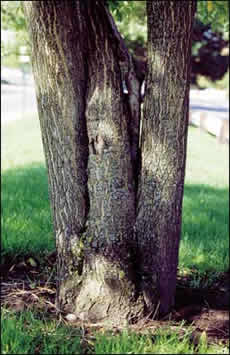 3. Multiple trunks are susceptible to splitting.
3. Multiple trunks are susceptible to splitting.
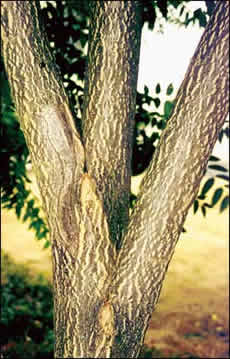 4. Weakly attached branches can eventually lead to branch failure.
4. Weakly attached branches can eventually lead to branch failure.
How to Recognize and Prevent Tree HazardsEight Warning Signs Every Homeowner Should KnowEvery year, our landscape changes as trees fall or break, causing property damage, power outages, and injury. While some tree failures are unpredictable, many can be prevented. By inspecting your trees for warning signs, many potential problems can be corrected before problems arise. Trees should be inspected on a regular basis especially before and after storms. Larger trees have a greater hazard potential than smaller trees. A hazardous tree is a tree that has significant structural defects that are likely to lead to failure and possibly cause injury or damage. If a tree is deemed hazardous, keep people, pets, and vehicles out of the area until the hazardous condition has been corrected. Seek Professional help from one of our certified arborists to evaluate the potential hazards before the next storm hits. We can recommend the proper course of action to keep your trees safer and healthier. The following guidelines can help you recognize the warning signs of hazard trees. For an interactive look at the signs of a hazard tree, watch Terrill Collier talk to the Garden Guy about specific characteristics of problem trees in this short video. 1. History.Past tree care, construction and landscape activities can affect the health of your trees. Construction, trenches, and tree topping can all have adverse effects on your trees. If roots have been cut or disturbed, the tree may become unstable. 2. Lean.Trees do not necessarily grow straight up. However, trees with a significant lean may indicate a problem. Look for cracked soil and exposed roots around the base of the tree which may indicate the tree has recently begun to lean. 3. Multiple Trunks.Some trees develop multiple trunks. Trees with multiple trunks can break if the trunks are weakly attached. Trees with large trunks with splits or cracks have a high failure potential. Inspect these trees for cracks or splits where the trunks meet. 4. Weakly Attached Branches.Inspect branches where they attach to the trunk. Tight V-shaped forks are more prone to break than open U-shaped unions. Trees with splits, cracks, and/or several branches arising from the same point on the trunk may also present problems. 5. Cavities & Decay Pockets.Inspect the trunk or branches for peeling bark and hollow or decayed areas. Large decay pockets and decay where branches meet the trunk can indicate serious structural problems. Mushrooms or conks growing on or at the base of a tree are signs of decay-causing fungus. 6. Trunk & Branch Cracks.Inspect the trunk and large branches for cracks. Deep, large cracks indicate structural weakness in the tree and need careful evaluation. 7. Hangers.Hangers are broken branches still lodged in the tree. Whether partially attached or separated completely from the trunk, hangers are likely to fall unexpectedly and should be removed. Stubs left by broken branches should be removed to prevent spread of decay. 8. Deadwood.Dead branches, or deadwood, will eventually fall. Branches over two inches in diameter can cause serious damage when they fall. Removal of deadwood may not be critical, but it should not be ignored. Find Out MoreGet tips on how to make your trees safer. Please consult with one of our arborists when you need advice or work done on your trees. Call us in Portland at 503-722-7267 and in Vancouver at 360-693-6056.
|
||||
What you can do
What a Collier Arbor Care Certified Arborist can do for you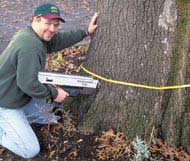 Lyle Feilmeier, certified arborist, uses the Resistograph™ to help detect and assess decay in trees.
Lyle Feilmeier, certified arborist, uses the Resistograph™ to help detect and assess decay in trees.
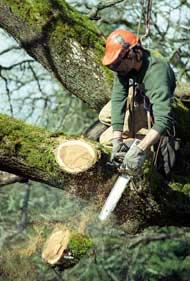 John Dale, certified arborist, prunes the Signature Oak Tree at the Oregon Garden. Crown cleaning removes deadwood, keeping trees healthy and safer
John Dale, certified arborist, prunes the Signature Oak Tree at the Oregon Garden. Crown cleaning removes deadwood, keeping trees healthy and safer
Depending on your tree care needs, a Collier Arborist might…
Trees are alive. Their integrity and stability change over time. Inspect your trees regularly to ensure their longevity and health. |
|
Home |
Services |
The Arbor Advisor |
Garden Calendar |
About Us |
Fact Sheets |
Contact Us |
Site Map Collier Arbor Care Portland 503-722-7267 Vancouver (360) 693-6056 Site contents and design ©2013 Collier Arbor Care |
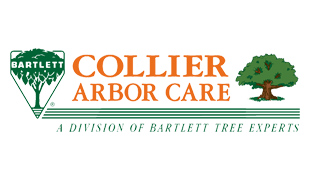





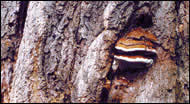
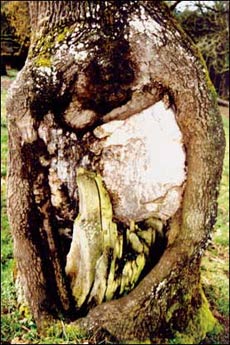 5. This oak tree with a large trunk wound is one example of a decay pocket.
5. This oak tree with a large trunk wound is one example of a decay pocket.
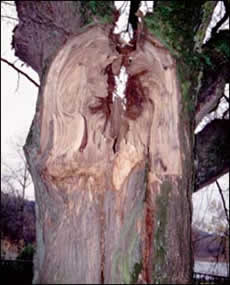 6. Trunk cracks are not always obvious as in this tree. Be sure to inspect both the trunk and large branches.
6. Trunk cracks are not always obvious as in this tree. Be sure to inspect both the trunk and large branches.
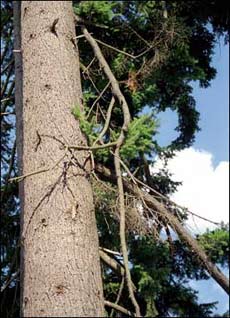 7. Hanging dead branches in this Douglas-fir are likely to fall and should be removed immediately.
7. Hanging dead branches in this Douglas-fir are likely to fall and should be removed immediately.
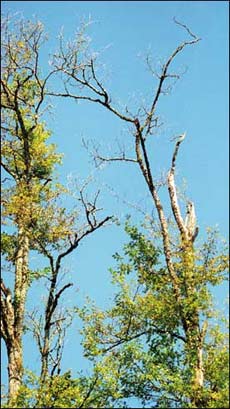 8. Deadwood in this tree should be removed before failure occurs.
8. Deadwood in this tree should be removed before failure occurs.